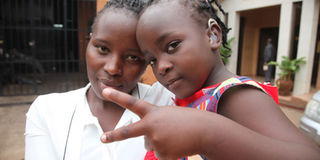Nanjjala needs Shs110m to correct hearing problem

Nanjjala flashes a V-sign during the interview. Her mother Imma Kamugabo says she noticed the impairment when she was about three-and-half years old. Photo by Stephen Wandera.
What you need to know:
- The electrodes then stimulate the auditory nerve and the brain interprets the signals as sounds. During rehabilitation, after the surgery, the brain is trained to understand the sounds that are being transmitted through the cochlear implant. For children, the best results occur when the implantation surgery is done at a young age.
Like any other five-year-old child, Kimberly Adela Nanjjala can hardly settle in one place for more than a minute.
She is very active, inspecting the contents of her mother’s purse, checking to see what is under the chair, and then, jumping up and down.
Her favourite game seems to be hide and seek, with her mother running after her as she hides behind a car.
She is a jolly little child, shrieking and laughing as she runs around.
However, Nanjjala has only one word in her vocabulary – bye. She was three and a half years in 2015, when her mother, Imma Kamugabo, a researcher, realised that she has a hearing impairment.
“Kimberley is my first child and has always been hyperactive. While I went to work, she would remain at home with the housemaid. That is why it took me so long to notice that there was something wrong,” she says.
Instead of talking, Kamugabo says, she would murmur some words and whenever I would call her name, I had to shout it out before she would respond.
“Honestly, I did not expect her to be deaf,” she says.
Genesis of impairment
It was only after a friend asked her if the girl had begun talking that it dawned on Kamugabo that she needed to take the child to a specialist.
Her first stop was St Francis Hospital Nsambya in October 2015.
“The hospital did not have the equipment to carryout tests. So the ENT specialist recommended that I visit International Hospital Kampala (IHK). The doctor there sent me to Kampala Audiology and Speech Centre for tests,” she says.
The test could not be carried out, however, because it was discovered that Nanjjala’s eardrum appeared dull and she had fluid in the middle ear.
At IHK, the doctor gave the child a one-month course of treatment to remove the fluids and the general consensus was that if the fluids were removed, the child would be able to hear.
“That did not happen,” Kamugabo say, adding: “We went for a Brain MRI (magnetic resonance imaging) scan and ABR test. The MRI was normal but the ABR showed that Kimberley has profound sensorineural hearing loss. She can only hear sounds above 90 decibels.”
An Auditory Brainstem Response (ABR) checks how the cochlear (inner ear) and the brain pathways for hearing are working.
One could liken 90 decibels to standing near a big aircraft as it lands standing next to a printing press, or an ambulance passing by.
Nanjjala was given analogue hearing aid from Naguru Hospital to stimulate her hearing.
“We were referred to Aga Khan University Hospital in Nairobi for more tests. The doctors confirmed that she needed a cochlear implant to rectify the problem. The surgery costs Shs110m. As we wait for surgery we bought hearing aid from Nairobi Audiology Centre at Shs6m. They had to be programmed to amplify sound up to her hearing level,” she says.
After the electrodes are planted into Nanjjala’s cochlear, she will be able to hear.
She also needs to be rehabilitated with the help of a speech therapist who will teach her how to talk again. The entire treatment will last the course of one year.
About cochlear implant
This is an electronic device that is placed in the inner ear to provide a sense of sound to someone with a hearing impairment.
They have an external component that is placed outside the skin, behind the ear. It contains a microphone, sound processor, and a transmitter.
The internal part of the implant is placed under the skin on the temporal bone. It has a receiver which collects the signals from the transmitter and converts them into electrical pulses. These pulses are dispatched to the electrodes that have been inserted into the middle ear (cochlear).
The electrodes then stimulate the auditory nerve and the brain interprets the signals as sounds. During rehabilitation, after the surgery, the brain is trained to understand the sounds that are being transmitted through the cochlear implant. For children, the best results occur when the implantation surgery is done at a young age.
Appeal for help
The surgery is expected to be carried out on April 15. However, of the Shs110m needed, the family has so far raised Shs35m from friends and relatives.
To raise more money, the family is organising a car wash at Panamera Bar and Lounge on March 24.
Well-wishers can also send money to an account in Centenary Bank, Account Name: Kamugabo Imma; Account Number 3200364142.




